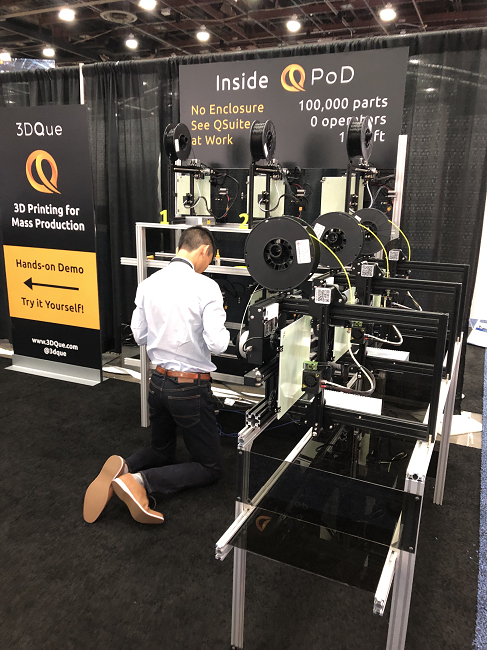AutoPrint3D is a new 3D printing automation from 3DQue for all 3D printers based on Merlin firmware, including unmodified systems and those with part removal tools and routines. With an annual subscription of $10 per printer per month, potential users can test out the software with a free seven-day trial
Canadian firm 3DQue has been working on automating print farms for a number of years now. Its main product is Quinly, a subscription-based automation suite for desktop 3D printers. In its simplest version, the tool performs remote monitoring with printer video streaming, as well as remote start and stop, spaghetti detection.
AutoPrint3D takes this a step further by adding automatic print bed calibration and leveling, automated part removal, and reporting. With systems outfitted with component removal tools, the software makes it possible for various part removal systems to run through the night without any operator involvement.
AutoFarm3D incorporates further capabilities, including maintenance scheduling, a shared print queue, and more analytics. At $30 per month per printer, this version seems a bit steep in my own opinion. However, these tools are meant to save time for universities and manufacturers who rely on desktop 3D printers. By allowing users to initiate, schedule, and monitor batch jobs, it could could make an operation more efficient.
3DQue has also developed the VAAPR self-cleaning print bed, which prints at an angle and saves additional set up and turnaround time. Additionally, the company’s SmartTags act as a drag-and-drop queue system that is easy to manipulate and could save time. For example, if a user’s printer has a “PA 11” tag assigned to it, then print jobs to be fabricated from that material will be assigned to that printer.
“Most print management solutions are focused on moving tasks closer to the operator by shifting them from the printer to the computer. AutoPrint3D eliminates tasks altogether and then streamlines the automated tasks, giving operators more time for innovation, creation and growth,” said 3DQue CEO Steph Sharp.
“Our original automation kits had to be modified for every model of printer. We could not develop custom solutions quickly enough to keep up with demand so we decided to open the software, giving the users an easy, affordable way to get automated printing without buying a whole new printer,” contributed 3DQue COI, Mateo Pekic.
Though the team at 3DQue may sometimes explain the capabilities of its tools in an unnecessarily confusing manner, they are performing critically useful work in 3D printing. Desktop 3D printers are increasingly more competent and reliable. There are now a growing number of print farms with dozens or hundreds of low-cost systems as printing services or straight manufacturing.
With Replique now relying on metal filaments and Ultimaker systems to 3D print spare parts for train companies, increased innovation is close at hand. Simple metal sintered parts greatly expand the capabilities of desktop machines. Another step will come as these systems are able to print more materials more reliably.
I really believe in a model whereby desktop 3D printers linked via specialty software produce millions of parts are made for maintenance, repair, and overhaul (MRO), along with manufacturing, mass customization, and more. If a print fails, a new one can be made on another system. If the printer fails, rip it out and replace it. 3D printing is developing in the same way as servers did, in which redundant, less expensive machines in racks replaced the super machines of yesteryear.

3DQue
Now, of course, a fancier, industrial system is more reliable. They also offer greater traceability and tighter integration with software. However, not everyone is trying to make components for Airbus. For some, inexpensive parts from desktop 3D printers may be a sufficient solution. These items will have to be finished and won’t be terribly pretty, but they will improve in time.
On the whole, I believe that there is a giant potential category of components out there that could reliably be 3D printed at scale with desktop machines. Millions of items that will cost significantly less than those from industrial 3D machines would be a true disruption to our industry. And, yes, desktop printers won’t produce as goods as fine as powder bed fusion parts. They won’t be as reliable as industrial systems. In some cases, they won’t be as cheap as some processes either. However, it would only have to be effective for a tiny sliver of components to achieve meaningful volume.
Subscribe to Our Email Newsletter
Stay up-to-date on all the latest news from the 3D printing industry and receive information and offers from third party vendors.
Print Services
Upload your 3D Models and get them printed quickly and efficiently.
You May Also Like
The Dental Additive Manufacturing Market Could Nearly Double by 2033, According to AM Research
According to an AM Research report from 2024, the medical device industry, specifically in dentistry, prosthetics, and audiology, is expected to see significant growth as these segments continue to benefit from...
Heating Up: 3D Systems’ Scott Green Discusses 3D Printing’s Potential in the Data Center Industry
The relentless rise of NVIDIA, the steadily increasing pledges of major private and public investments in national infrastructure projects around the world, and the general cultural obsession with AI have...
AM Research Webinar Explores Continuum’s Sustainable Metal Additive Manufacturing Powders
Metal additive manufacturing (AM) powder supplier Continuum Powders is working to develop solutions that empower industries to reduce waste and optimize their resources. An independent life cycle assessment (LCA) of...
3D Printed Footwear Startup Koobz Lands $7.2M in Seed Round
California-based Koobz is focused on reshoring the U.S. footwear supply chain with advanced manufacturing processes, including 3D printing. The startup just announced that it has added $6 million to its...
































